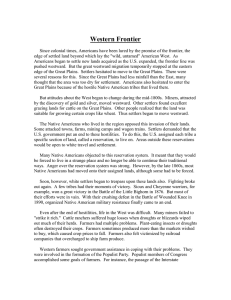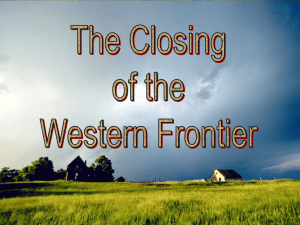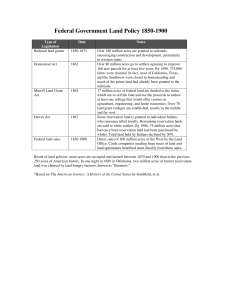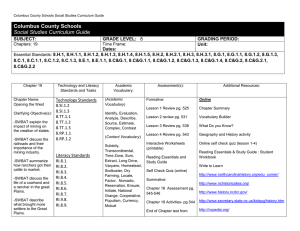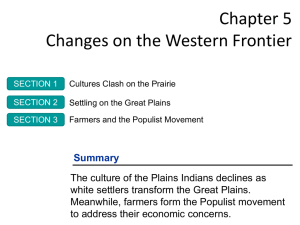Chapter 2 Lesson 2 - Guthrie Public Schools
advertisement
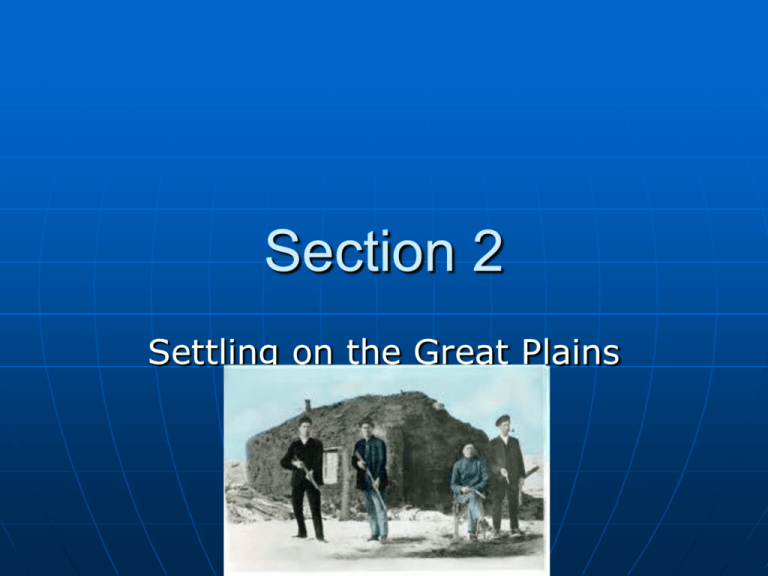
Section 2 Settling on the Great Plains Settlers Move Westward to Farm Took 250 yrs to turn 400 million acres of forests and prairies into flourishing farms • Settling the second 400 million acres took only 30 yrs (1870-1900) Federal land policies and the completion of the transcontinental railroad lines made it possible Railroads Open the West 1850-1871 federal govt made huge land grants to the railroads for laying track • • Both the Union Pacific and the Central Pacific received • • 10 sq miles of public land for every mile of track laid in a state 20 sq miles of land for every mile of track laid in territory Central Pacific moved eastward from Sacramento, Union Pacific moved westward from Omaha • 170 million acres Worth half a billion dollars Civil War vets, Irish, Chinese, African Americans, and Mexican Americans did most of the labor Both companies reached Utah by the spring of 1869 • 15 yrs later, the country boasted five transcontinental railroads RR companies sold some land to farmers for two to ten dollars an acre Some successfully sent agents to Europe to recruit buyers By 1880, 44% of the settlers in Nebraska and more than 70% in Minnesota and Wisconsin were immigrants Government Support for Settlement Homestead Act (1862) • Offered 160 acres of land free to any citizen or intended citizen who was head of the household • 600,000 Families took advantage Exodusters—Af Am who moved from the post-Reconstruction South to Kansas • Private speculators, railroad agents, and govt agents used the law for their own gain • Cattlemen fenced open lands, miners and wood cutters claimed national resources • Only 10% of the land was actually settled by the families for whom it was intended Not all plots of land were equal Expanded the Homestead Act • 1889 land giveaway in what is now Oklahoma attracted thousands • Less than a day settlers claimed 2 million acres The Closing of the Frontier Henry D. Washburn and fellow explorer Nathaniel P Langford asked Congress to help protect the wilderness from settlement • 1870 surveying land in NW Wyoming described the area’s geysers and bubbling springs as “objects new experience…possessing unlimited grandeur and beauty” 1872, created Yellowstone National Park • Railroads had to give up their claim to western landholdings 1880 individuals had bought more then 19 million acres of govt owned land • 10 yrs later the Census Bureau declared that the country no longer had a continuous frontier line (frontier no longer existed) Settlers Meet the Challenges of the Plains Settlers faced extreme hardships • Drought, floods, fires, blizzards, locust plaques, occasional raids by outlaws or natives However, national population grew from 1% in west of the Mississippi to 30% of the population Dugouts and Soddies Dugouts • Dug their homes into the sides of ravines or small hills • A stove pipe jutting from the ground was often the only clear sign of a dugout Soddies • Made freestanding houses by stacking blocks of prairie turf • Was warm in the winter and cool in the summer • Small offered little light or air • Havens for snakes, insects, etc • Were fireproof but leaked continuously when it rained Women Working Often worked beside the men in the fields, plowing the land and planting and harvesting the predominant crop (wheat) Sheared sheep and carded wool to make clothes for their families Hauled water from wells that they helped dig Made soap and candles from tallow (fat from sheep and cattle) Canned fruits and veggies Skilled at doctoring sponsored schools and churches Technical Support for Farmers Inventions • 1837 John Deere invented a steel plow that could slice through heavy soil • 1847 Cyrus McCormick mass-produced a reaping machine • Spring tooth harrow to prepare the soil • Grain drill to plant the seed • Barbed wire corn binder • Reaper that could cut and thresh wheat in one pass 1890 there were more than 900 manufacturers for farm equipment 1830 a bushel of grain took about 183 min, by 1900 it took only 10 min Agricultural Education Morrill Act of 1862 and 1890 • Gave federal land to the states to help finance agricultural colleges Hatch Act of 1887 • Est agricultural experiment stations to inform farmers of new developments Researchers developed grains for arid soil and techniques for dry farming • Enabled the dry eastern plains to flourish and become “the breadbasket of the nation” Farmers in Debt Machinery was expensive, often they would have to borrow Prices for wheat were higher farmers could usually repay their loans when they were low farmers needed to raise more crops to make ends meet Gave rise to a new type of farming • Bonanza farming Enormous single-crops spreads of 15,000-50,000 acres Slowly folded because they weren’t as flexible as small farms Railroads charged western farmers a higher fee • Charged more for short hauls (no competition) • RR said it was just business, farmers resented being taken advantage of Section 2 Review 1) Review the changes in technology that influenced the life of settlers on the Great Plains in the late 1800’s. Explain how you think settlement of the plains would have been different without these inventions. 2) How did the railroads take advantage of farmers?
